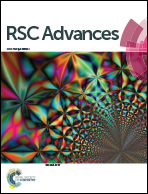A coral-inspired nanoscale design of Sn–Cu/PANi/GO hybrid anode materials for high performance lithium-ion batteries
Abstract
A facile and scalable synthesis approach is developed for fabrication of a three-dimensional (3D) polyaniline (PANi)/graphene oxide (GO) hybrid hydrogel evenly embed with hollow Sn–Cu nanoparticles (Sn–Cu NPs) as high performance anode for lithium-ion batteries. The hierarchical conductive hydrogel was prepared via in situ polymerization of aniline monomer on the surface of Sn–Cu NPs and GO nanosheets. The morphology and structure of the resulting hybrid materials have been characterized using scanning electron microscopy (SEM) and transmission electron microscopy (TEM). The hierarchical conductive hydrogel framework with dendritic PANi nanofibers and 2D GO nanosheets serve as a continuous 3D electron transport network and high porosity to accommodate the volume expansion of Sn–Cu NPs. The PANi coating plays an “artificial SEI” function to preserve the structural and interfacial stabilization of Sn–Cu NPs during the cycling processes. As a consequence of this 3D hybrid anode, an extremely long stable cycling performance is achieved with reversible discharge capacity over 693 mA h g−1 after 200 cycles at current rate of 0.2 C and a reversible capacity of 371 mA h g−1 retention at a much higher current rate of 2 C, suggesting that this novel Sn–Cu/PANi/GO composite is a promising candidate for energy storage applications.


 Please wait while we load your content...
Please wait while we load your content...